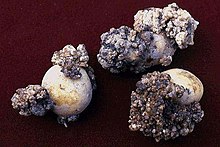Synchytrium endobioticum
| Synchytrium endobioticum | |
|---|---|
 |
|
| Scientific classification | |
| Kingdom: | Fungi |
| Division: | Chytridiomycota |
| Class: | Chytridiomycetes |
| Order: | Synchytriales |
| Family: | Synchytriaceae |
| Genus: | Synchytrium |
| Species: | S. endobioticum |
| Binomial name | |
|
Synchytrium endobioticum (Schilb.) Percival 1909 |
|
Synchytrium endobioticum is a chytrid fungus that causes the potato wart disease or black scab. It also infects some other plants of the Solanum genus, though potato is the only cultivated host.
Traditionally, Synchytrium endobioticum has been placed to the subgenus Mesochytrium, but it has been suggested that on the basis of the mode of germination it should be transferred to the subgenus Microsynchytrium. It was first identified and studied by Vera Charles. The New Zealand scientist Kathleen Maisey Curtis also studied Synchytrium endobioticum for her doctoral thesis that, in 1919, resulted in her being recognised as producing groundbreaking research on the organism's pathology.
At least 18 pathotypes of the fungus exist, most of them with quite limited ranges in Central Europe. The most widely distributed is the pathotype 1.
Like some other Chytridiales, Synchytrium endobioticum develops no mycelium. The fungus produces a thick walled structure known as a winter sporangium. It is 25-75 µm in diameter and contains 200-300 spores. Sporangia are clustered into thin-walled soruses. The motile life stage, zoospore is about 0,5 µm in diameter and has one posterior flagellum.
In spring, at higher temperature and moisture, overwintering sporangia germinate to release mobile zoospores which infect suitable host epidermal cells. In infected cells, the summer sporangia develop, which quickly release new populations of zoospores. The infection cycle may be repeated as long as infection conditions are suitable. The infected plant cells swell, divide and surround the dividing zoospores resulting in the wart.
Under certain stress conditions some zoospore pairs fuse, resulting in a zygote. The zygote bearing host cells divide, forming eventually the walls of a new winter sporangium. In autumn, the warts rot and disintegrate, releasing new thick-walled resting spores of the fungus into the soil. The diploid resting spores (pro-soruses) undergo a dormancy period and before germination (probably) a meiotic division and several mitotic divisions, becoming a sorus.
...
Wikipedia
